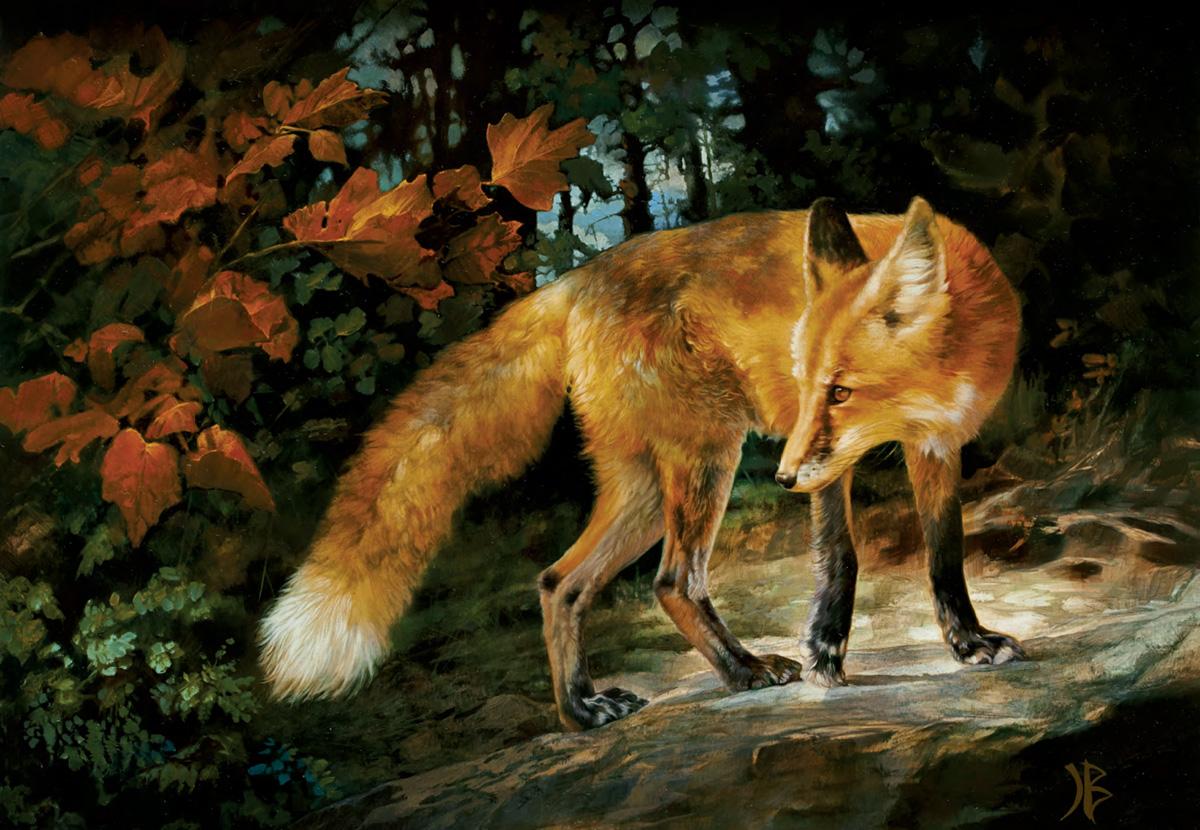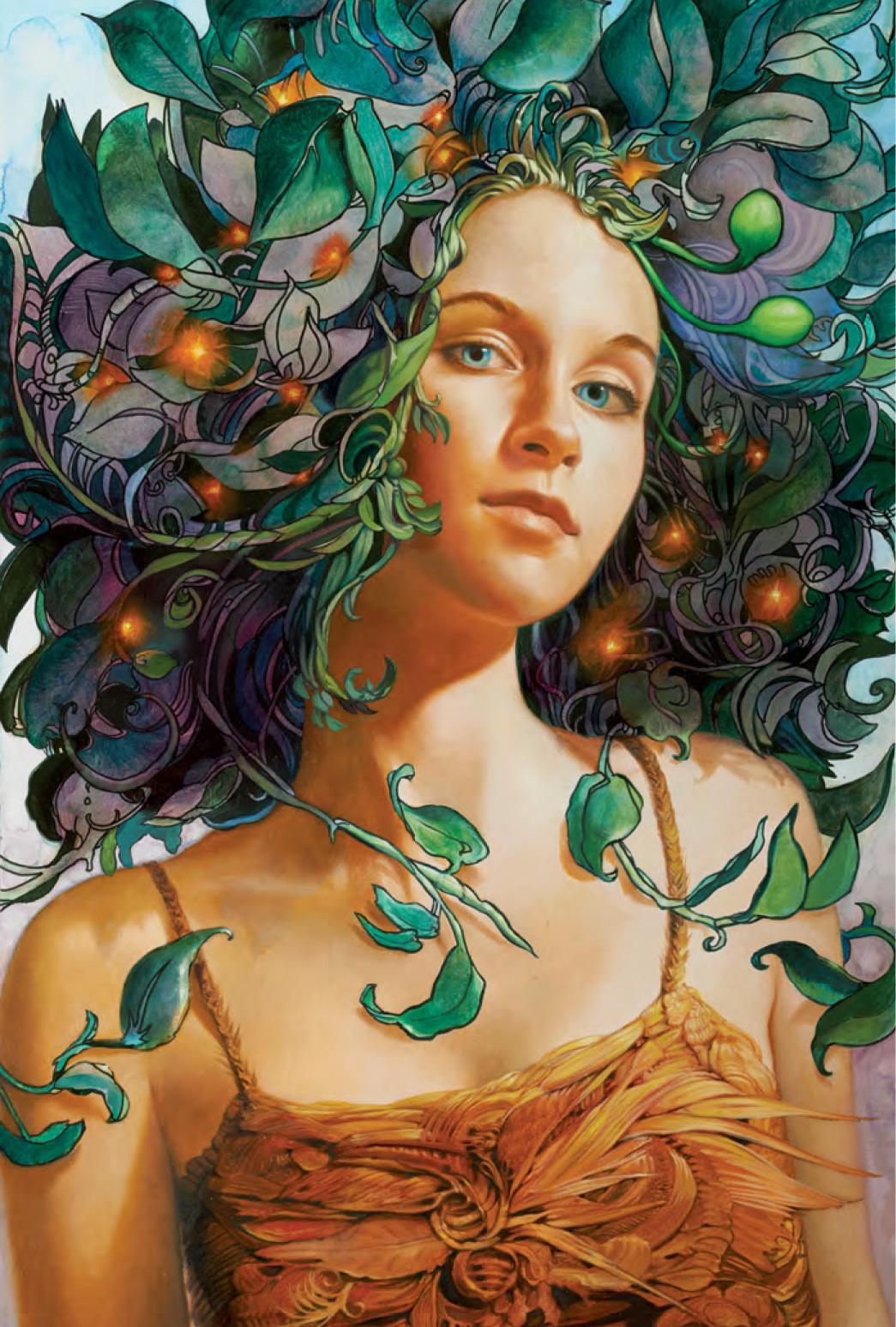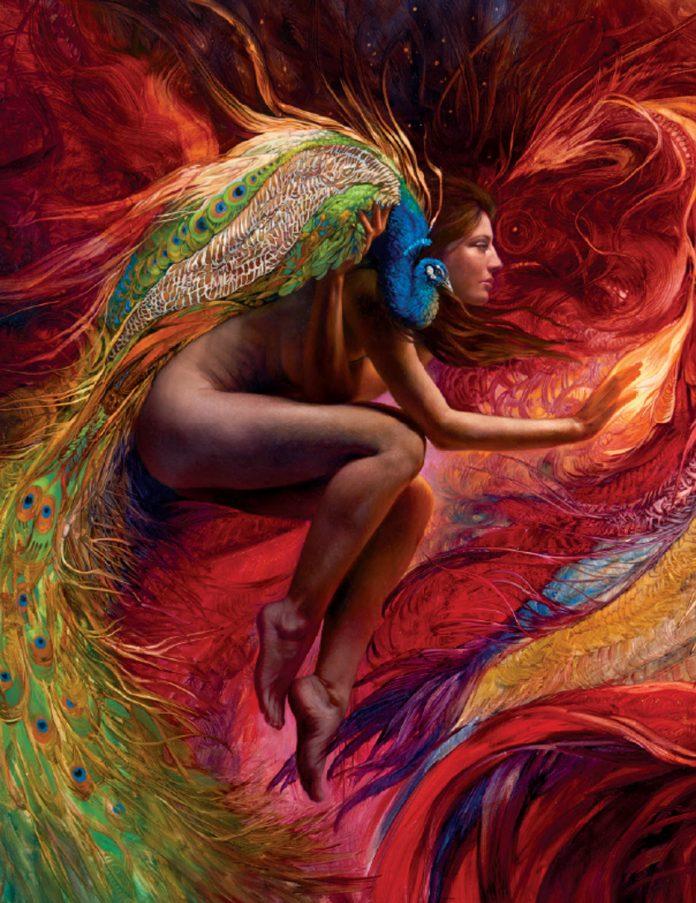Admirers of fantasy and science-fiction art will no doubt already be familiar with Julie Bell’s name. She’s had over five hundred works of art published for the purposes of illustration and marketing since she began working in 1990, including the cover of Meat Loaf ’s Bat Out of Hell III: The Monster Is Loose, the poster for the Aqua Teen Hunger Force movie, and countless video-game covers, advertising campaign images, and book covers (all this in addition to being a former IFBB nationally ranked bodybuilder who still maintains a healthy fitness regimen). We recently asked Bell to talk with us about her work and the strong women depicted therein.
Faerie Magazine: The theme of this issue is “Warriors and Goddesses.” Can you give us an example of any artworks you created of a female subject that felt especially strong and goddess-like to you?
Julie Bell: In my painting Peacock and Firebird, I was initially inspired by my model. As the concept developed, I began to realize that it was revealing some of my own personal discoveries to me. She is holding onto the peacock, which to me represents the vanities of the self that she once thought were the best thing she had to offer. She is confronted with the firebird’s call and, when she touches it, she will release the peacock and zoom into a new path that takes her into a different universe. The truth in allowing that flow that she’s finding becomes her ultimate strength.
FM: How would you define a warrior woman? What does strength mean to you?
JB: To me, strength is coming to a point where you suddenly realize that owning and respecting your own truth is an unshakable power. I thought I knew what this meant years ago, but I had no idea what it really meant until a few years ago. I’ll probably say the same thing a few years from now!
FM: How has your background in bodybuilding affected your approach to your art subjects, both human and animal? In what ways does your knowledge of musculature and body strength come into play?
JB: I’ve always been fascinated by the body, both in my art and in a more scientific way. I was a national-level competitor in bodybuilding during the ’80s, and my approach was to read everything I could find about nutrition and training. This was before the internet, so I spent a lot of time at libraries reading all the different opinions and theories people had on the subject. Having a firsthand perspective on what creates powerful motions and expresses energy has been enormously valuable to me. Also, I studied ballet as a child and as an adult and have always been exhilarated by the way the body can express energy lines through its directional movements, down to the tiniest details like eye and ear position. We are animals after all, and we see these details even when they’re subconscious!

FM: Can you tell us a little bit about your work process? How do your ideas go from concept to execution?
JB: My process of developing a concept for a painting varies. Sometimes I start out with a very clear and precise vision of what I want to paint. It could have been inspired by a dream or a piece of music, but often it starts because of my slight nearsightedness. I don’t wear my glasses all the time, and I see the most amazing world of magical stories and creatures with my naked eyes! Then when I put on my glasses, I realize, Oh, it’s just a drain pipe next to an air conditioning unit. But I grab the ideas and sketch some of them down in a sketchbook for future inspiration. Then when I come back to them, they take on a whole different dimension anyway, so you never know.
Then again, sometimes I just start putting paint on a blank canvas and letting the paint speak to me with color and swirls. All my life I’ve loved to see pictures in the clouds and trees, so I can really use this to my advantage.
And then again, sometimes I just shoot some cool pictures of a model or an animal and become inspired by the photo. The funny thing is that it rarely ends up being what I initially planned for. So often, one tiny aspect of the image will send me off in a completely different direction. I like to think of this as being a partner with my painting, alternating holding the reins and relinquishing control. It’s a cooperative process with my mystical self!
FM: We are Faerie Magazine, and you are not unfamiliar with the painting of a fairy subject. Can you talk to us about how you approach the creation of an ethereal image vs. a mortal one?
JB: That’s actually kind of tough for me to separate. Aside from down-to-earth clothing vs. naked bodies or magical jewels that somehow attach themselves to “areas of interest,” I don’t see much difference. I can’t help but think about how our mortal bodies are created out of swirly vibrations and basically nothing. So if I need to make a point that a person is mortal in a painting, I guess it’s mostly in the choice of clothing and lack of wings or scales.
FM: We have noticed your more recent art with human subjects has a more stylized and colorful look, while still using your awareness of human anatomy. Can you tell us more about these recent paintings?
JB: I had previously mostly paired human subjects with dragons and other fantasy creatures, but I started thinking about how cool it would be to put them with real animals instead. But I couldn’t escape from my own natural tendencies, and they ended up being very surreal and dreamlike. For example, in the painting Behind the Veil, which shows a lady floating with insane zebras, I didn’t really start out with all that insanity going on.
But as I went along the path, it became more and more crazy, and I remembered that I used to have a recurring dream when I was a kid about accidentally knocking down the power line that went through the trees in my backyard. When it fell, the power line just went berserk, jumping and forming all kinds of shapes. Then it turned into a really mean zebra that was chasing me through my school.
Next thing you knew, the army was chasing me too, for knocking down the power line, etc. etc. Anyway, I’m thinking surreal with these pieces and, as I mentioned before, allowing my more mystical thoughts to emerge. The colors and stylization happen on their own.

FM: One of the artworks you sent us, entitled Lucinda, has a different feel from some of your other work and a young woman as a subject. Can you tell us more about the project for which this was created?
JB: Yes! This is an illustration from an upcoming children’s novel written by Sherry Lazarus Ross called The Vinetrope Adventures, Book One: The Return of the Vinetropes. It comes out in June and I’m very excited about it. The story is so unique and creative, and I can’t wait to see how the world reacts to it. Sherry and I have become best friends in the process of creating the book. We recognized an immediate connection in how we think about nature and the universe, and I’m so happy that she chose me to illustrate her book. You’re all going to love it!



































I am really satisfied with this posting that you have given us. This is really nicr work done by you. Thank you and looking for more posts.
Informative post, this is. It is always nice to come across a post that is useful.
I have been checking out many of your posts and it’s nice stuff. I will definitely bookmark your website.